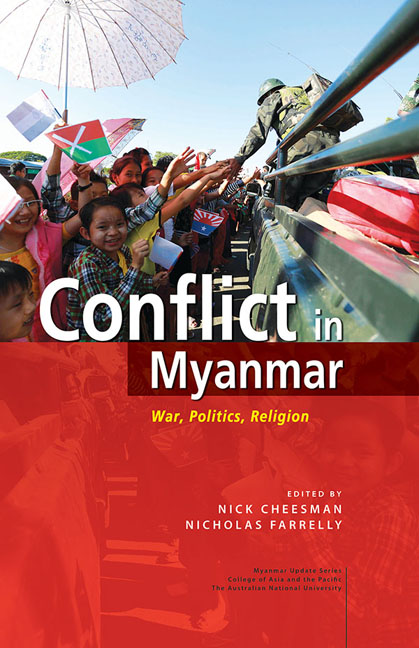Book contents
- Frontmatter
- Contents
- List of Maps
- List of Tables
- List of Figures
- Acknowledgements
- Contributors and Editors
- Part I Introduction
- Part II War and Order
- Part III Elections and After
- Part IV Us and Them
- 12 Making sense of reactions to communal violence in Myanmar
- 13 Public perceptions of a divided Myanmar: Findings from the 2015 Myanmar Asian Barometer Survey
- 14 On Islamophobes and Holocaust deniers: Making sense of violence, in Myanmar and elsewhere
- 15 Buddhist welfare and the limits of big ‘P’ politics in provincial Myanmar
- 16 Threat perceptions in the Myanmar–Bangladesh borderlands
- Part V Conclusion
- Abbreviations and Key Terms
- Index
12 - Making sense of reactions to communal violence in Myanmar
from Part IV - Us and Them
Published online by Cambridge University Press: 22 July 2017
- Frontmatter
- Contents
- List of Maps
- List of Tables
- List of Figures
- Acknowledgements
- Contributors and Editors
- Part I Introduction
- Part II War and Order
- Part III Elections and After
- Part IV Us and Them
- 12 Making sense of reactions to communal violence in Myanmar
- 13 Public perceptions of a divided Myanmar: Findings from the 2015 Myanmar Asian Barometer Survey
- 14 On Islamophobes and Holocaust deniers: Making sense of violence, in Myanmar and elsewhere
- 15 Buddhist welfare and the limits of big ‘P’ politics in provincial Myanmar
- 16 Threat perceptions in the Myanmar–Bangladesh borderlands
- Part V Conclusion
- Abbreviations and Key Terms
- Index
Summary
In June 2012 the rape and murder of a Buddhist girl in Western Rakhine State sparked reprisals against Muslim communities. The resulting cycles of communal violence in the following months left hundreds dead, and thousands displaced. The tensions in Rakhine State continued through 2012, and by early 2013 the violence began to spread to other areas of the country. In Meiktila, in the country's central dry zone, a dispute in a jewellery store saw an escalation of violence and the burning of significant parts of the Muslim quarter, including mosques and schools. Through the rest of 2013 tensions remained high, and there continued to be isolated incidents of violence, especially in Rakhine State.
In October 2013, Mishal Husain interviewed Daw Aung San Suu Kyi on the BBC's Today programme. When asked about growing communal conflict between Buddhists and Muslims in Myanmar, Suu Kyi responded, “This is what the world needs to understand: that the fear is not just on the side of the Muslims, but on the side of the Buddhists as well. Yes, Muslims have been targeted, but also Buddhists have been subjected to violence” (BBC 2013). And when finally asked pointedly whether she condemned the anti-Muslim violence, she replied that, “I condemn any movement that is based on hatred and extremism” (BBC 2013).
Over the next few days, Suu Kyi was heavily criticized by the Western media for supposedly defending Buddhist extremism. Daily Telegraph reporter David Blair said that the interview had “sent a shiver down my spine” and that her attitudes toward Muslims were “deeply disturbing” (Blair 2013). Others described the interview as a “fall from grace” from the democracy icon (4News). One commentator even suggested that Suu Kyi should now be “shunned by the international community” (4News). While this condemnation was focused specifically on Aung San Suu Kyi, it was representative of a shift that was also taking place in the attitudes of the international aid community toward the democracy movement.
Previously, like Suu Kyi, democracy activists and opposition leaders had been considered allies of Western aid organizations’ interests in the country. Yet this perception shifted dramatically with the contrasting reactions to reports of violence against Muslims.
- Type
- Chapter
- Information
- Conflict in MyanmarWar, Politics, Religion, pp. 245 - 260Publisher: ISEAS–Yusof Ishak InstitutePrint publication year: 2016

